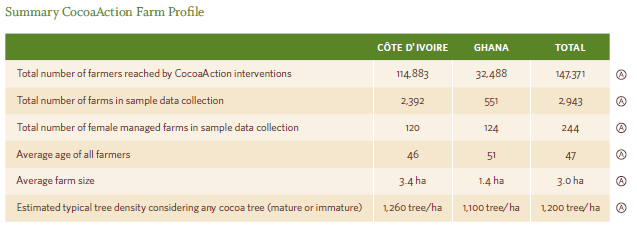As all of you are aware, yesterday and the weeks leading up to it were a big deal in the candy world.
Halloween brings scares, tricks and — of course — treats. The National Retail Federation predicted U.S. consumers would spend $2.7 billion on candy for the 2017 holiday, and One Click Retail, an ecommerce research and analytics firm, noted online retailer Amazon raked in $19.5 million in candy sales in September and October alone.
That’s pretty staggering, whether or not you’re nursing a sweets-induced hangover today. (For the record, I certainly am. It’s hard to resist when the pieces are individually wrapped or appear in “fun size” packages.)
But there’s a lot that goes into getting candy into jack-o-lantern buckets, pillowcases and our faces — especially for chocolate, which according to One Click’s Amazon figures, rules the Halloween roost. Of the $13 million in candy sales generated in October, $8 million came from chocolate.
And without cocoa, there is no chocolate for Halloween celebrations or any other festive activities, for that matter. The holidays are, after all, right around the corner.
So, as many industry titans have realized, much work needs to be done to protect cocoa and support the farmers and communities that produce it. In 2014, the World Cocoa Foundation launched CocoaAction, an overarching strategy that aligns the sustainability goals of leading cocoa and chocolate companies, governments in Cote D’Ivoire and Ghana and other stakeholders.
Barry Callebaut Group, Blommer Chocolate Co., Cargill Cocoa & Chocolate, Ferrero Group, The Hershey Co., Mars, Inc., Mondelez International, Nestlé and Olam are all involved, developing their own initiatives and programs that correspond with common targets to improve productivity and promote community development.
Among the emphasized concerns are low productivity, pests and disease, environmental concerns, market challenges, access to education, child protection and gender equality. By 2020, the participating companies aim to support 300,000 cocoa farmers in adopting CocoaAction productivity practices and 1,200 Cote D’Ivorian and Ghanaian communities through various interventions.
CocoaAction began collecting data and rolling out community development and productivity practices last year. And they’ve made progress, according to the program’s new annual report, but there’s still a long way to go.
“In the first year of implementation, CocoaAction achieved verifiable progress that points to even greater promise,” wrote World Cocoa Foundation Chairman Barry Parkin in the report’s foreword. “We know, however, that real and sustainable change takes time. As we travel this journey and learn through experience the lessons about what works best and what most needs improving, we must be prepared to refresh and recalibrate our approach.”
In 2016, CocoaAction partners brought cocoa productivity package interventions to 147,000 farmers — nearly half of its 2020 benchmark. They also identified 330 communities that would benefit from interventions such as preventing child labor practices, increasing primary education and empowering women to join and help build a sustainable cocoa industry.

Source: World Cocoa Foundation
CocoaAction also collected 15,000 data points, which offers an overall picture of the status of cocoa productivity and cocoa-producing communities. However, as the report notes, collecting the data came with challenges in consistency, particularly when it pertained to cocoa yields. Further training for data collectors and experimenting with different approaches are needed.
Nonetheless, the data is worth reviewing. Of the 147,000 farmers reached, 3,100 were recommended for and have adopted full productivity packages. However, the report notes, adopting the program’s Good Agricultural Practices (GAP) — especially ones for soil management and replanting and rehabilitating trees — may be difficult for farmers with limited financial means.
The report said 30 percent of CocoaAction farmers in Cote D’Ivoire have adopted four of five required GAP, while 23 percent in Ghana have done so. A breakdown of specific practices and adoption rates appears below.

Source: World Cocoa Foundation
Practices for harvest management and pest and disease management have proved popular among CocoaAction farmers in both countries, but those pertaining to tree pruning, weed management and shade management have not been as widely adopted.
In terms of harvest management, CocoaAction recommends replacing underperforming trees and planting new trees in densities that maximize available space but still provide them enough light. The report also noted farmers don’t know the cocoa varieties they’re growing, and most farms weren’t ready to use fertilizer, based on tree age, tree density and use of other GAP.
The cocoa market also presents a barrier to adopting GAP, the report said. In the last quarter of 2016, the world trade price for cocoa dropped from $2,711 per ton to $2,288. These initiatives promote long-term sustainability, but they don’t offer much return in the short term. Further investment in productivity, as well as expanding the global chocolate and cocoa market, are projected to help.
Productivity and market challenges are only half the battle, however. CocoaAction companies have also begun conducting community needs assessments in cocoa-growing communities — 83 in Cote D’Ivoire and 244 in Ghana, respectively. Furthermore, 14,762 farmers have been involved in systems for monitoring and remediating child labor cases.
CocoaAction is off to a laudable start, and for the sake of all involved, I hope the program’s participating farmers and companies continue to make progress. Working together is the only way to make the cocoa industry sustainable for years — and Halloweens — to come.

